Effects of Mental Health Services on Indigenous Australian Communities
VerifiedAdded on 2022/09/01
|15
|4788
|25
Report
AI Summary
This report examines the effects of mental health services on Aboriginal and Torres Strait Islander communities. The report analyzes several research articles focusing on the impact of mental health support services, including the methods and treatments used, and the importance of considering the values and beliefs of these communities. The methodology involves a mixed-methods approach, primarily qualitative, using questionnaires, interviews, and case studies to understand the complexities of the topic. The research explores the effectiveness of various interventions, such as Aboriginal Mental Health Liaison Officers and outreach case management, and the challenges in implementing e-mental health services. It highlights the need for culturally appropriate and community-based approaches to improve mental health outcomes, including suicide prevention and the use of digital mental health programs. The report emphasizes the importance of addressing the unique needs of Aboriginal and Torres Strait Islander peoples to ensure effective and equitable mental health care.
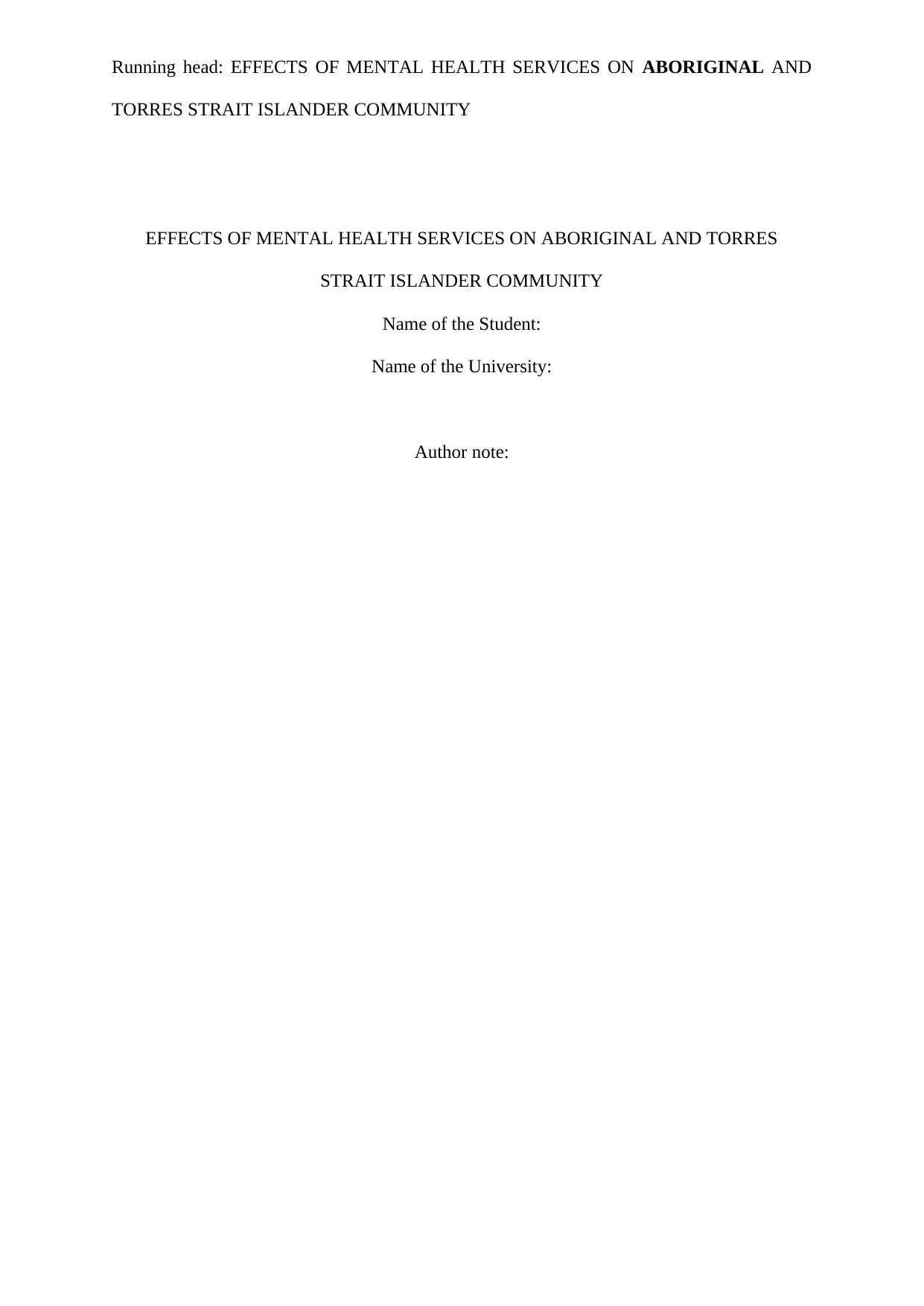
Running head: EFFECTS OF MENTAL HEALTH SERVICES ON ABORIGINAL AND
TORRES STRAIT ISLANDER COMMUNITY
EFFECTS OF MENTAL HEALTH SERVICES ON ABORIGINAL AND TORRES
STRAIT ISLANDER COMMUNITY
Name of the Student:
Name of the University:
Author note:
TORRES STRAIT ISLANDER COMMUNITY
EFFECTS OF MENTAL HEALTH SERVICES ON ABORIGINAL AND TORRES
STRAIT ISLANDER COMMUNITY
Name of the Student:
Name of the University:
Author note:
Paraphrase This Document
Need a fresh take? Get an instant paraphrase of this document with our AI Paraphraser
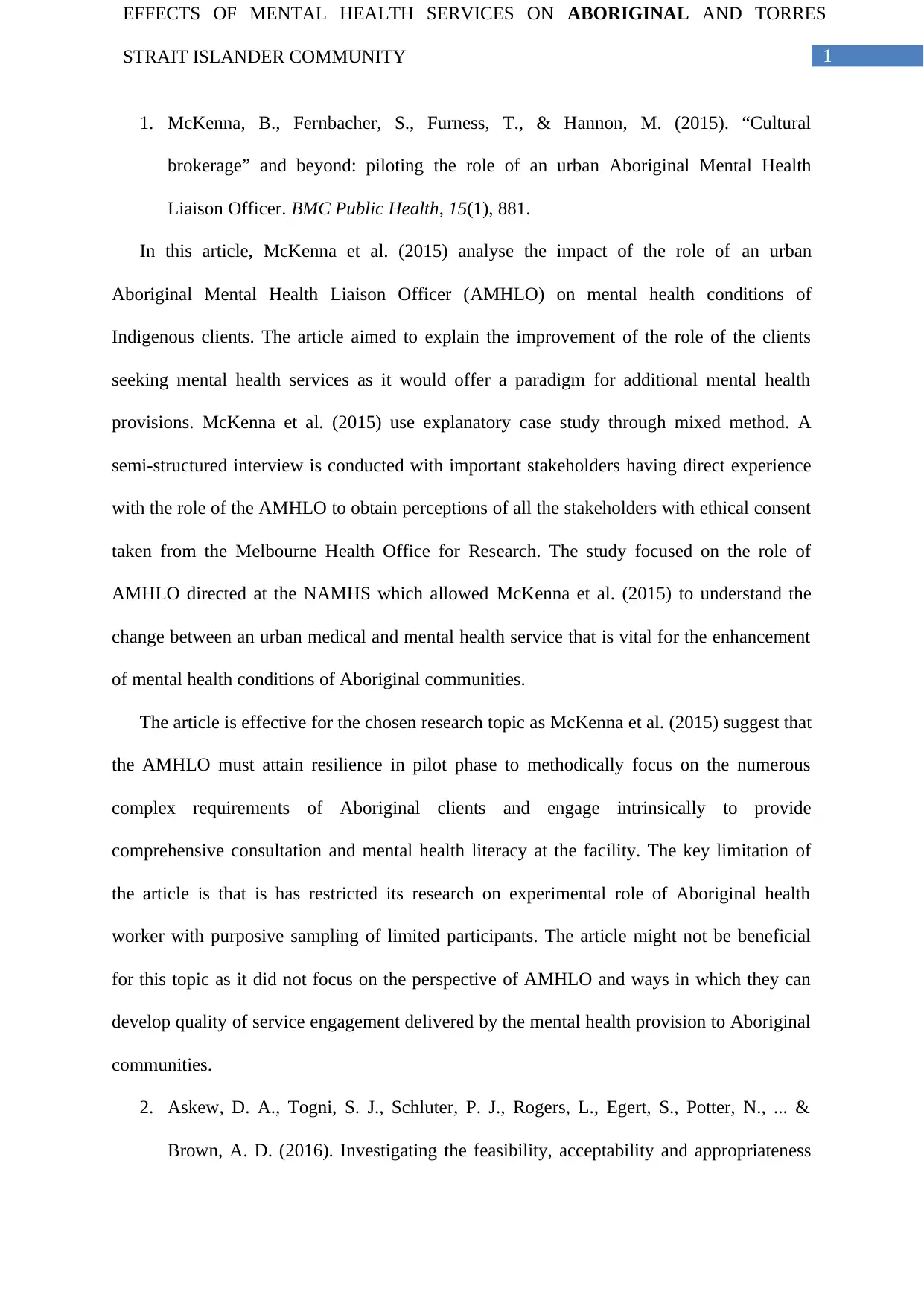
1
EFFECTS OF MENTAL HEALTH SERVICES ON ABORIGINAL AND TORRES
STRAIT ISLANDER COMMUNITY
1. McKenna, B., Fernbacher, S., Furness, T., & Hannon, M. (2015). “Cultural
brokerage” and beyond: piloting the role of an urban Aboriginal Mental Health
Liaison Officer. BMC Public Health, 15(1), 881.
In this article, McKenna et al. (2015) analyse the impact of the role of an urban
Aboriginal Mental Health Liaison Officer (AMHLO) on mental health conditions of
Indigenous clients. The article aimed to explain the improvement of the role of the clients
seeking mental health services as it would offer a paradigm for additional mental health
provisions. McKenna et al. (2015) use explanatory case study through mixed method. A
semi-structured interview is conducted with important stakeholders having direct experience
with the role of the AMHLO to obtain perceptions of all the stakeholders with ethical consent
taken from the Melbourne Health Office for Research. The study focused on the role of
AMHLO directed at the NAMHS which allowed McKenna et al. (2015) to understand the
change between an urban medical and mental health service that is vital for the enhancement
of mental health conditions of Aboriginal communities.
The article is effective for the chosen research topic as McKenna et al. (2015) suggest that
the AMHLO must attain resilience in pilot phase to methodically focus on the numerous
complex requirements of Aboriginal clients and engage intrinsically to provide
comprehensive consultation and mental health literacy at the facility. The key limitation of
the article is that is has restricted its research on experimental role of Aboriginal health
worker with purposive sampling of limited participants. The article might not be beneficial
for this topic as it did not focus on the perspective of AMHLO and ways in which they can
develop quality of service engagement delivered by the mental health provision to Aboriginal
communities.
2. Askew, D. A., Togni, S. J., Schluter, P. J., Rogers, L., Egert, S., Potter, N., ... &
Brown, A. D. (2016). Investigating the feasibility, acceptability and appropriateness
EFFECTS OF MENTAL HEALTH SERVICES ON ABORIGINAL AND TORRES
STRAIT ISLANDER COMMUNITY
1. McKenna, B., Fernbacher, S., Furness, T., & Hannon, M. (2015). “Cultural
brokerage” and beyond: piloting the role of an urban Aboriginal Mental Health
Liaison Officer. BMC Public Health, 15(1), 881.
In this article, McKenna et al. (2015) analyse the impact of the role of an urban
Aboriginal Mental Health Liaison Officer (AMHLO) on mental health conditions of
Indigenous clients. The article aimed to explain the improvement of the role of the clients
seeking mental health services as it would offer a paradigm for additional mental health
provisions. McKenna et al. (2015) use explanatory case study through mixed method. A
semi-structured interview is conducted with important stakeholders having direct experience
with the role of the AMHLO to obtain perceptions of all the stakeholders with ethical consent
taken from the Melbourne Health Office for Research. The study focused on the role of
AMHLO directed at the NAMHS which allowed McKenna et al. (2015) to understand the
change between an urban medical and mental health service that is vital for the enhancement
of mental health conditions of Aboriginal communities.
The article is effective for the chosen research topic as McKenna et al. (2015) suggest that
the AMHLO must attain resilience in pilot phase to methodically focus on the numerous
complex requirements of Aboriginal clients and engage intrinsically to provide
comprehensive consultation and mental health literacy at the facility. The key limitation of
the article is that is has restricted its research on experimental role of Aboriginal health
worker with purposive sampling of limited participants. The article might not be beneficial
for this topic as it did not focus on the perspective of AMHLO and ways in which they can
develop quality of service engagement delivered by the mental health provision to Aboriginal
communities.
2. Askew, D. A., Togni, S. J., Schluter, P. J., Rogers, L., Egert, S., Potter, N., ... &
Brown, A. D. (2016). Investigating the feasibility, acceptability and appropriateness
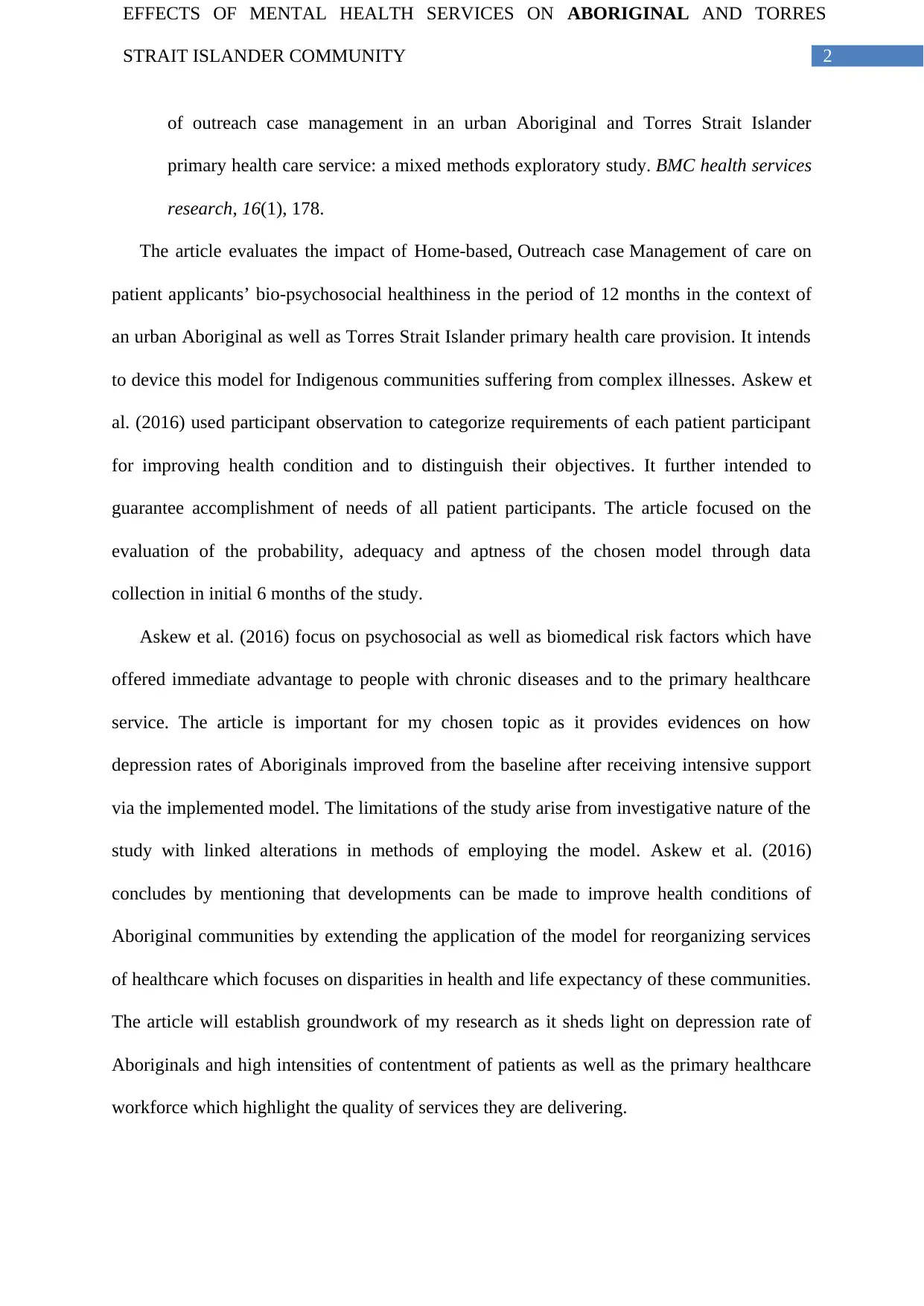
2
EFFECTS OF MENTAL HEALTH SERVICES ON ABORIGINAL AND TORRES
STRAIT ISLANDER COMMUNITY
of outreach case management in an urban Aboriginal and Torres Strait Islander
primary health care service: a mixed methods exploratory study. BMC health services
research, 16(1), 178.
The article evaluates the impact of Home-based, Outreach case Management of care on
patient applicants’ bio-psychosocial healthiness in the period of 12 months in the context of
an urban Aboriginal as well as Torres Strait Islander primary health care provision. It intends
to device this model for Indigenous communities suffering from complex illnesses. Askew et
al. (2016) used participant observation to categorize requirements of each patient participant
for improving health condition and to distinguish their objectives. It further intended to
guarantee accomplishment of needs of all patient participants. The article focused on the
evaluation of the probability, adequacy and aptness of the chosen model through data
collection in initial 6 months of the study.
Askew et al. (2016) focus on psychosocial as well as biomedical risk factors which have
offered immediate advantage to people with chronic diseases and to the primary healthcare
service. The article is important for my chosen topic as it provides evidences on how
depression rates of Aboriginals improved from the baseline after receiving intensive support
via the implemented model. The limitations of the study arise from investigative nature of the
study with linked alterations in methods of employing the model. Askew et al. (2016)
concludes by mentioning that developments can be made to improve health conditions of
Aboriginal communities by extending the application of the model for reorganizing services
of healthcare which focuses on disparities in health and life expectancy of these communities.
The article will establish groundwork of my research as it sheds light on depression rate of
Aboriginals and high intensities of contentment of patients as well as the primary healthcare
workforce which highlight the quality of services they are delivering.
EFFECTS OF MENTAL HEALTH SERVICES ON ABORIGINAL AND TORRES
STRAIT ISLANDER COMMUNITY
of outreach case management in an urban Aboriginal and Torres Strait Islander
primary health care service: a mixed methods exploratory study. BMC health services
research, 16(1), 178.
The article evaluates the impact of Home-based, Outreach case Management of care on
patient applicants’ bio-psychosocial healthiness in the period of 12 months in the context of
an urban Aboriginal as well as Torres Strait Islander primary health care provision. It intends
to device this model for Indigenous communities suffering from complex illnesses. Askew et
al. (2016) used participant observation to categorize requirements of each patient participant
for improving health condition and to distinguish their objectives. It further intended to
guarantee accomplishment of needs of all patient participants. The article focused on the
evaluation of the probability, adequacy and aptness of the chosen model through data
collection in initial 6 months of the study.
Askew et al. (2016) focus on psychosocial as well as biomedical risk factors which have
offered immediate advantage to people with chronic diseases and to the primary healthcare
service. The article is important for my chosen topic as it provides evidences on how
depression rates of Aboriginals improved from the baseline after receiving intensive support
via the implemented model. The limitations of the study arise from investigative nature of the
study with linked alterations in methods of employing the model. Askew et al. (2016)
concludes by mentioning that developments can be made to improve health conditions of
Aboriginal communities by extending the application of the model for reorganizing services
of healthcare which focuses on disparities in health and life expectancy of these communities.
The article will establish groundwork of my research as it sheds light on depression rate of
Aboriginals and high intensities of contentment of patients as well as the primary healthcare
workforce which highlight the quality of services they are delivering.
⊘ This is a preview!⊘
Do you want full access?
Subscribe today to unlock all pages.

Trusted by 1+ million students worldwide
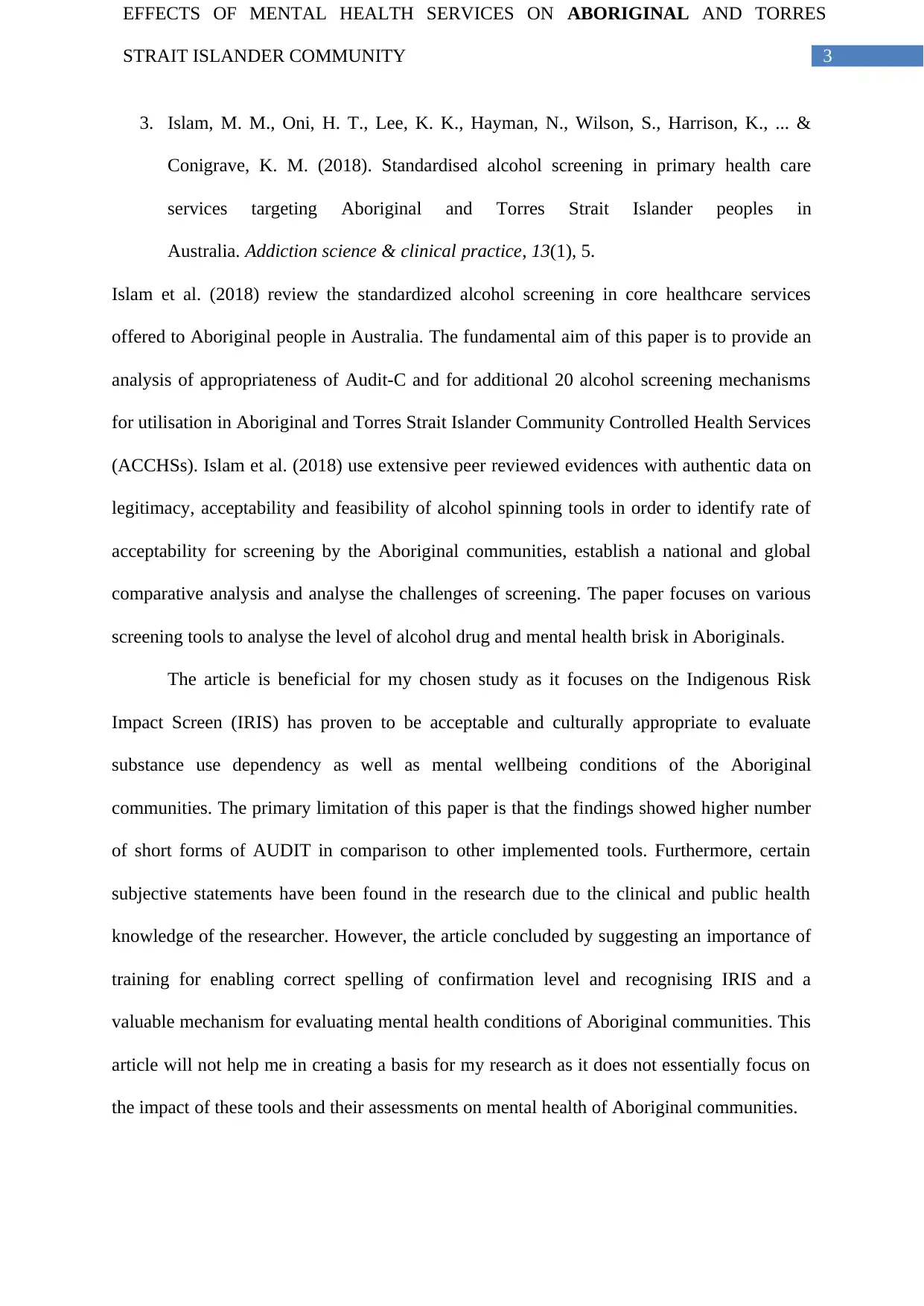
3
EFFECTS OF MENTAL HEALTH SERVICES ON ABORIGINAL AND TORRES
STRAIT ISLANDER COMMUNITY
3. Islam, M. M., Oni, H. T., Lee, K. K., Hayman, N., Wilson, S., Harrison, K., ... &
Conigrave, K. M. (2018). Standardised alcohol screening in primary health care
services targeting Aboriginal and Torres Strait Islander peoples in
Australia. Addiction science & clinical practice, 13(1), 5.
Islam et al. (2018) review the standardized alcohol screening in core healthcare services
offered to Aboriginal people in Australia. The fundamental aim of this paper is to provide an
analysis of appropriateness of Audit-C and for additional 20 alcohol screening mechanisms
for utilisation in Aboriginal and Torres Strait Islander Community Controlled Health Services
(ACCHSs). Islam et al. (2018) use extensive peer reviewed evidences with authentic data on
legitimacy, acceptability and feasibility of alcohol spinning tools in order to identify rate of
acceptability for screening by the Aboriginal communities, establish a national and global
comparative analysis and analyse the challenges of screening. The paper focuses on various
screening tools to analyse the level of alcohol drug and mental health brisk in Aboriginals.
The article is beneficial for my chosen study as it focuses on the Indigenous Risk
Impact Screen (IRIS) has proven to be acceptable and culturally appropriate to evaluate
substance use dependency as well as mental wellbeing conditions of the Aboriginal
communities. The primary limitation of this paper is that the findings showed higher number
of short forms of AUDIT in comparison to other implemented tools. Furthermore, certain
subjective statements have been found in the research due to the clinical and public health
knowledge of the researcher. However, the article concluded by suggesting an importance of
training for enabling correct spelling of confirmation level and recognising IRIS and a
valuable mechanism for evaluating mental health conditions of Aboriginal communities. This
article will not help me in creating a basis for my research as it does not essentially focus on
the impact of these tools and their assessments on mental health of Aboriginal communities.
EFFECTS OF MENTAL HEALTH SERVICES ON ABORIGINAL AND TORRES
STRAIT ISLANDER COMMUNITY
3. Islam, M. M., Oni, H. T., Lee, K. K., Hayman, N., Wilson, S., Harrison, K., ... &
Conigrave, K. M. (2018). Standardised alcohol screening in primary health care
services targeting Aboriginal and Torres Strait Islander peoples in
Australia. Addiction science & clinical practice, 13(1), 5.
Islam et al. (2018) review the standardized alcohol screening in core healthcare services
offered to Aboriginal people in Australia. The fundamental aim of this paper is to provide an
analysis of appropriateness of Audit-C and for additional 20 alcohol screening mechanisms
for utilisation in Aboriginal and Torres Strait Islander Community Controlled Health Services
(ACCHSs). Islam et al. (2018) use extensive peer reviewed evidences with authentic data on
legitimacy, acceptability and feasibility of alcohol spinning tools in order to identify rate of
acceptability for screening by the Aboriginal communities, establish a national and global
comparative analysis and analyse the challenges of screening. The paper focuses on various
screening tools to analyse the level of alcohol drug and mental health brisk in Aboriginals.
The article is beneficial for my chosen study as it focuses on the Indigenous Risk
Impact Screen (IRIS) has proven to be acceptable and culturally appropriate to evaluate
substance use dependency as well as mental wellbeing conditions of the Aboriginal
communities. The primary limitation of this paper is that the findings showed higher number
of short forms of AUDIT in comparison to other implemented tools. Furthermore, certain
subjective statements have been found in the research due to the clinical and public health
knowledge of the researcher. However, the article concluded by suggesting an importance of
training for enabling correct spelling of confirmation level and recognising IRIS and a
valuable mechanism for evaluating mental health conditions of Aboriginal communities. This
article will not help me in creating a basis for my research as it does not essentially focus on
the impact of these tools and their assessments on mental health of Aboriginal communities.
Paraphrase This Document
Need a fresh take? Get an instant paraphrase of this document with our AI Paraphraser
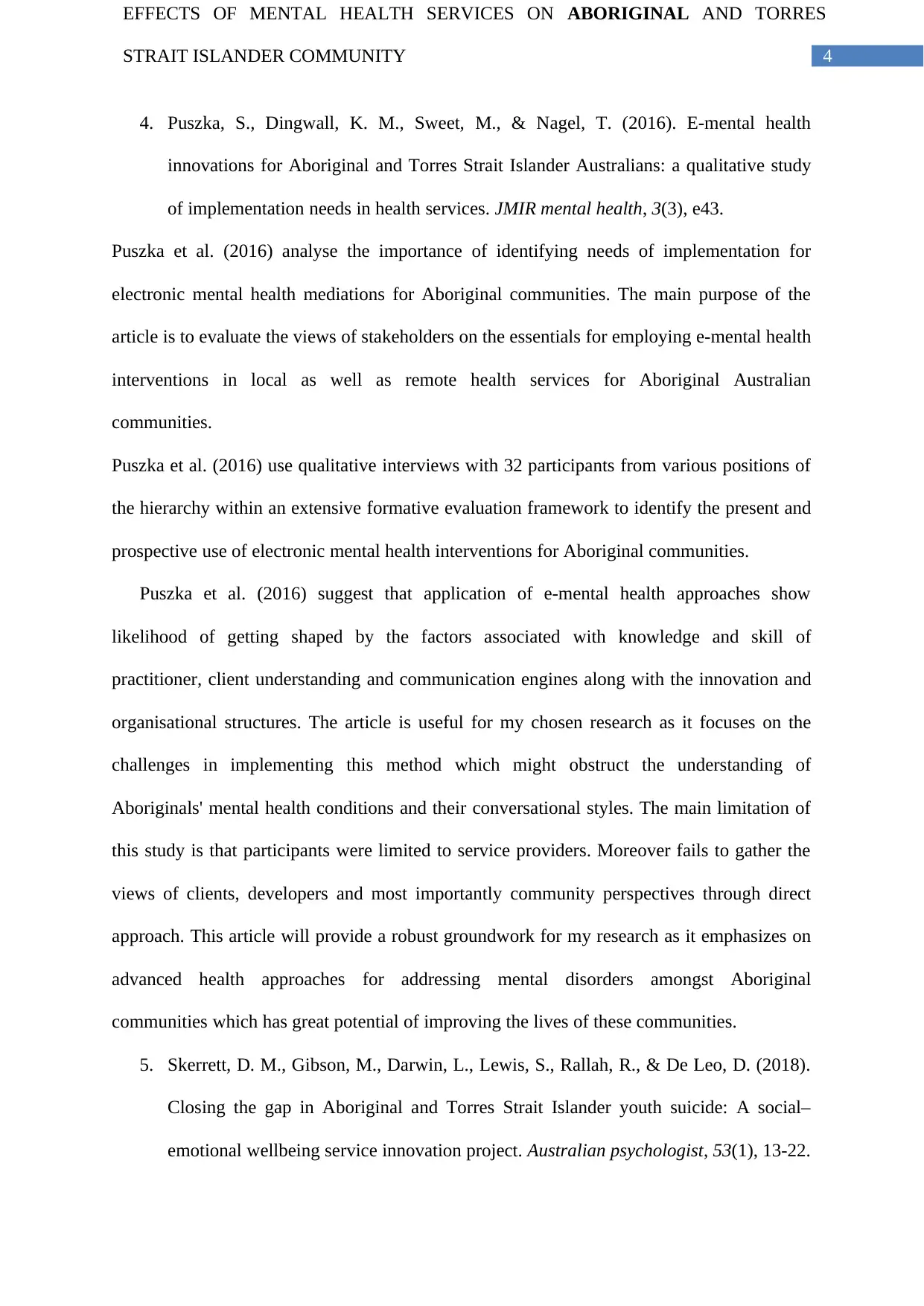
4
EFFECTS OF MENTAL HEALTH SERVICES ON ABORIGINAL AND TORRES
STRAIT ISLANDER COMMUNITY
4. Puszka, S., Dingwall, K. M., Sweet, M., & Nagel, T. (2016). E-mental health
innovations for Aboriginal and Torres Strait Islander Australians: a qualitative study
of implementation needs in health services. JMIR mental health, 3(3), e43.
Puszka et al. (2016) analyse the importance of identifying needs of implementation for
electronic mental health mediations for Aboriginal communities. The main purpose of the
article is to evaluate the views of stakeholders on the essentials for employing e-mental health
interventions in local as well as remote health services for Aboriginal Australian
communities.
Puszka et al. (2016) use qualitative interviews with 32 participants from various positions of
the hierarchy within an extensive formative evaluation framework to identify the present and
prospective use of electronic mental health interventions for Aboriginal communities.
Puszka et al. (2016) suggest that application of e-mental health approaches show
likelihood of getting shaped by the factors associated with knowledge and skill of
practitioner, client understanding and communication engines along with the innovation and
organisational structures. The article is useful for my chosen research as it focuses on the
challenges in implementing this method which might obstruct the understanding of
Aboriginals' mental health conditions and their conversational styles. The main limitation of
this study is that participants were limited to service providers. Moreover fails to gather the
views of clients, developers and most importantly community perspectives through direct
approach. This article will provide a robust groundwork for my research as it emphasizes on
advanced health approaches for addressing mental disorders amongst Aboriginal
communities which has great potential of improving the lives of these communities.
5. Skerrett, D. M., Gibson, M., Darwin, L., Lewis, S., Rallah, R., & De Leo, D. (2018).
Closing the gap in Aboriginal and Torres Strait Islander youth suicide: A social–
emotional wellbeing service innovation project. Australian psychologist, 53(1), 13-22.
EFFECTS OF MENTAL HEALTH SERVICES ON ABORIGINAL AND TORRES
STRAIT ISLANDER COMMUNITY
4. Puszka, S., Dingwall, K. M., Sweet, M., & Nagel, T. (2016). E-mental health
innovations for Aboriginal and Torres Strait Islander Australians: a qualitative study
of implementation needs in health services. JMIR mental health, 3(3), e43.
Puszka et al. (2016) analyse the importance of identifying needs of implementation for
electronic mental health mediations for Aboriginal communities. The main purpose of the
article is to evaluate the views of stakeholders on the essentials for employing e-mental health
interventions in local as well as remote health services for Aboriginal Australian
communities.
Puszka et al. (2016) use qualitative interviews with 32 participants from various positions of
the hierarchy within an extensive formative evaluation framework to identify the present and
prospective use of electronic mental health interventions for Aboriginal communities.
Puszka et al. (2016) suggest that application of e-mental health approaches show
likelihood of getting shaped by the factors associated with knowledge and skill of
practitioner, client understanding and communication engines along with the innovation and
organisational structures. The article is useful for my chosen research as it focuses on the
challenges in implementing this method which might obstruct the understanding of
Aboriginals' mental health conditions and their conversational styles. The main limitation of
this study is that participants were limited to service providers. Moreover fails to gather the
views of clients, developers and most importantly community perspectives through direct
approach. This article will provide a robust groundwork for my research as it emphasizes on
advanced health approaches for addressing mental disorders amongst Aboriginal
communities which has great potential of improving the lives of these communities.
5. Skerrett, D. M., Gibson, M., Darwin, L., Lewis, S., Rallah, R., & De Leo, D. (2018).
Closing the gap in Aboriginal and Torres Strait Islander youth suicide: A social–
emotional wellbeing service innovation project. Australian psychologist, 53(1), 13-22.
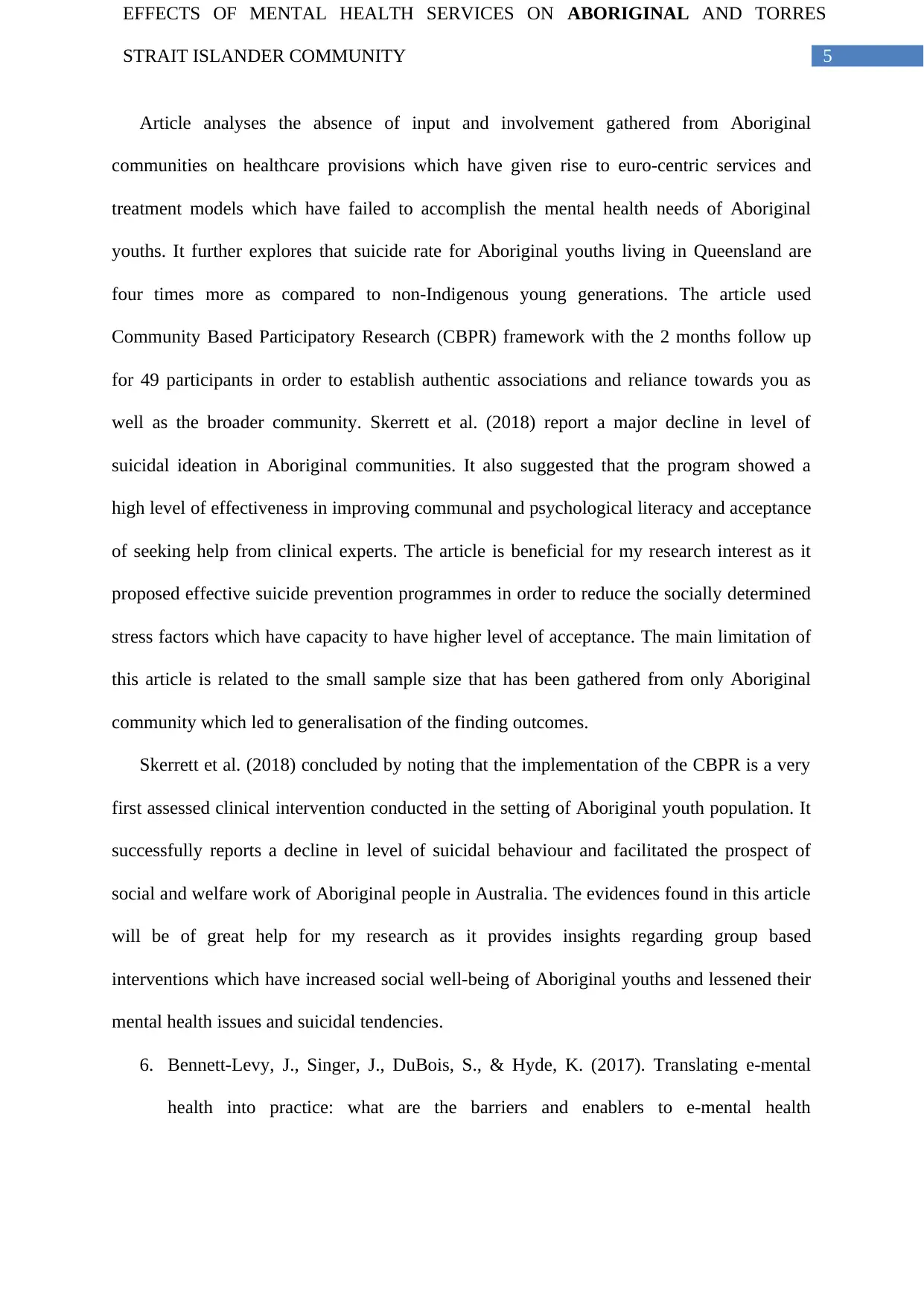
5
EFFECTS OF MENTAL HEALTH SERVICES ON ABORIGINAL AND TORRES
STRAIT ISLANDER COMMUNITY
Article analyses the absence of input and involvement gathered from Aboriginal
communities on healthcare provisions which have given rise to euro-centric services and
treatment models which have failed to accomplish the mental health needs of Aboriginal
youths. It further explores that suicide rate for Aboriginal youths living in Queensland are
four times more as compared to non-Indigenous young generations. The article used
Community Based Participatory Research (CBPR) framework with the 2 months follow up
for 49 participants in order to establish authentic associations and reliance towards you as
well as the broader community. Skerrett et al. (2018) report a major decline in level of
suicidal ideation in Aboriginal communities. It also suggested that the program showed a
high level of effectiveness in improving communal and psychological literacy and acceptance
of seeking help from clinical experts. The article is beneficial for my research interest as it
proposed effective suicide prevention programmes in order to reduce the socially determined
stress factors which have capacity to have higher level of acceptance. The main limitation of
this article is related to the small sample size that has been gathered from only Aboriginal
community which led to generalisation of the finding outcomes.
Skerrett et al. (2018) concluded by noting that the implementation of the CBPR is a very
first assessed clinical intervention conducted in the setting of Aboriginal youth population. It
successfully reports a decline in level of suicidal behaviour and facilitated the prospect of
social and welfare work of Aboriginal people in Australia. The evidences found in this article
will be of great help for my research as it provides insights regarding group based
interventions which have increased social well-being of Aboriginal youths and lessened their
mental health issues and suicidal tendencies.
6. Bennett-Levy, J., Singer, J., DuBois, S., & Hyde, K. (2017). Translating e-mental
health into practice: what are the barriers and enablers to e-mental health
EFFECTS OF MENTAL HEALTH SERVICES ON ABORIGINAL AND TORRES
STRAIT ISLANDER COMMUNITY
Article analyses the absence of input and involvement gathered from Aboriginal
communities on healthcare provisions which have given rise to euro-centric services and
treatment models which have failed to accomplish the mental health needs of Aboriginal
youths. It further explores that suicide rate for Aboriginal youths living in Queensland are
four times more as compared to non-Indigenous young generations. The article used
Community Based Participatory Research (CBPR) framework with the 2 months follow up
for 49 participants in order to establish authentic associations and reliance towards you as
well as the broader community. Skerrett et al. (2018) report a major decline in level of
suicidal ideation in Aboriginal communities. It also suggested that the program showed a
high level of effectiveness in improving communal and psychological literacy and acceptance
of seeking help from clinical experts. The article is beneficial for my research interest as it
proposed effective suicide prevention programmes in order to reduce the socially determined
stress factors which have capacity to have higher level of acceptance. The main limitation of
this article is related to the small sample size that has been gathered from only Aboriginal
community which led to generalisation of the finding outcomes.
Skerrett et al. (2018) concluded by noting that the implementation of the CBPR is a very
first assessed clinical intervention conducted in the setting of Aboriginal youth population. It
successfully reports a decline in level of suicidal behaviour and facilitated the prospect of
social and welfare work of Aboriginal people in Australia. The evidences found in this article
will be of great help for my research as it provides insights regarding group based
interventions which have increased social well-being of Aboriginal youths and lessened their
mental health issues and suicidal tendencies.
6. Bennett-Levy, J., Singer, J., DuBois, S., & Hyde, K. (2017). Translating e-mental
health into practice: what are the barriers and enablers to e-mental health
⊘ This is a preview!⊘
Do you want full access?
Subscribe today to unlock all pages.

Trusted by 1+ million students worldwide
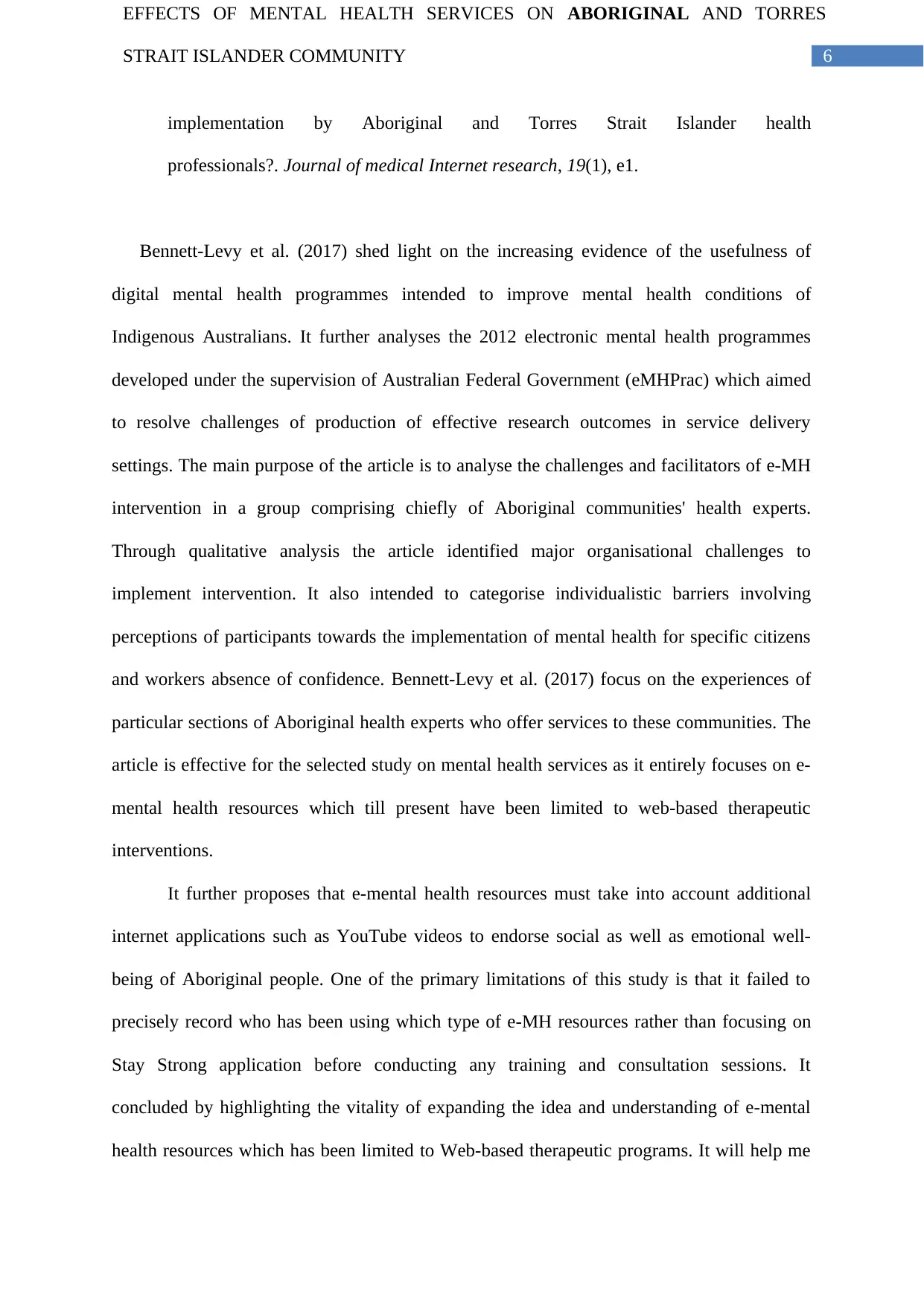
6
EFFECTS OF MENTAL HEALTH SERVICES ON ABORIGINAL AND TORRES
STRAIT ISLANDER COMMUNITY
implementation by Aboriginal and Torres Strait Islander health
professionals?. Journal of medical Internet research, 19(1), e1.
Bennett-Levy et al. (2017) shed light on the increasing evidence of the usefulness of
digital mental health programmes intended to improve mental health conditions of
Indigenous Australians. It further analyses the 2012 electronic mental health programmes
developed under the supervision of Australian Federal Government (eMHPrac) which aimed
to resolve challenges of production of effective research outcomes in service delivery
settings. The main purpose of the article is to analyse the challenges and facilitators of e-MH
intervention in a group comprising chiefly of Aboriginal communities' health experts.
Through qualitative analysis the article identified major organisational challenges to
implement intervention. It also intended to categorise individualistic barriers involving
perceptions of participants towards the implementation of mental health for specific citizens
and workers absence of confidence. Bennett-Levy et al. (2017) focus on the experiences of
particular sections of Aboriginal health experts who offer services to these communities. The
article is effective for the selected study on mental health services as it entirely focuses on e-
mental health resources which till present have been limited to web-based therapeutic
interventions.
It further proposes that e-mental health resources must take into account additional
internet applications such as YouTube videos to endorse social as well as emotional well-
being of Aboriginal people. One of the primary limitations of this study is that it failed to
precisely record who has been using which type of e-MH resources rather than focusing on
Stay Strong application before conducting any training and consultation sessions. It
concluded by highlighting the vitality of expanding the idea and understanding of e-mental
health resources which has been limited to Web-based therapeutic programs. It will help me
EFFECTS OF MENTAL HEALTH SERVICES ON ABORIGINAL AND TORRES
STRAIT ISLANDER COMMUNITY
implementation by Aboriginal and Torres Strait Islander health
professionals?. Journal of medical Internet research, 19(1), e1.
Bennett-Levy et al. (2017) shed light on the increasing evidence of the usefulness of
digital mental health programmes intended to improve mental health conditions of
Indigenous Australians. It further analyses the 2012 electronic mental health programmes
developed under the supervision of Australian Federal Government (eMHPrac) which aimed
to resolve challenges of production of effective research outcomes in service delivery
settings. The main purpose of the article is to analyse the challenges and facilitators of e-MH
intervention in a group comprising chiefly of Aboriginal communities' health experts.
Through qualitative analysis the article identified major organisational challenges to
implement intervention. It also intended to categorise individualistic barriers involving
perceptions of participants towards the implementation of mental health for specific citizens
and workers absence of confidence. Bennett-Levy et al. (2017) focus on the experiences of
particular sections of Aboriginal health experts who offer services to these communities. The
article is effective for the selected study on mental health services as it entirely focuses on e-
mental health resources which till present have been limited to web-based therapeutic
interventions.
It further proposes that e-mental health resources must take into account additional
internet applications such as YouTube videos to endorse social as well as emotional well-
being of Aboriginal people. One of the primary limitations of this study is that it failed to
precisely record who has been using which type of e-MH resources rather than focusing on
Stay Strong application before conducting any training and consultation sessions. It
concluded by highlighting the vitality of expanding the idea and understanding of e-mental
health resources which has been limited to Web-based therapeutic programs. It will help me
Paraphrase This Document
Need a fresh take? Get an instant paraphrase of this document with our AI Paraphraser
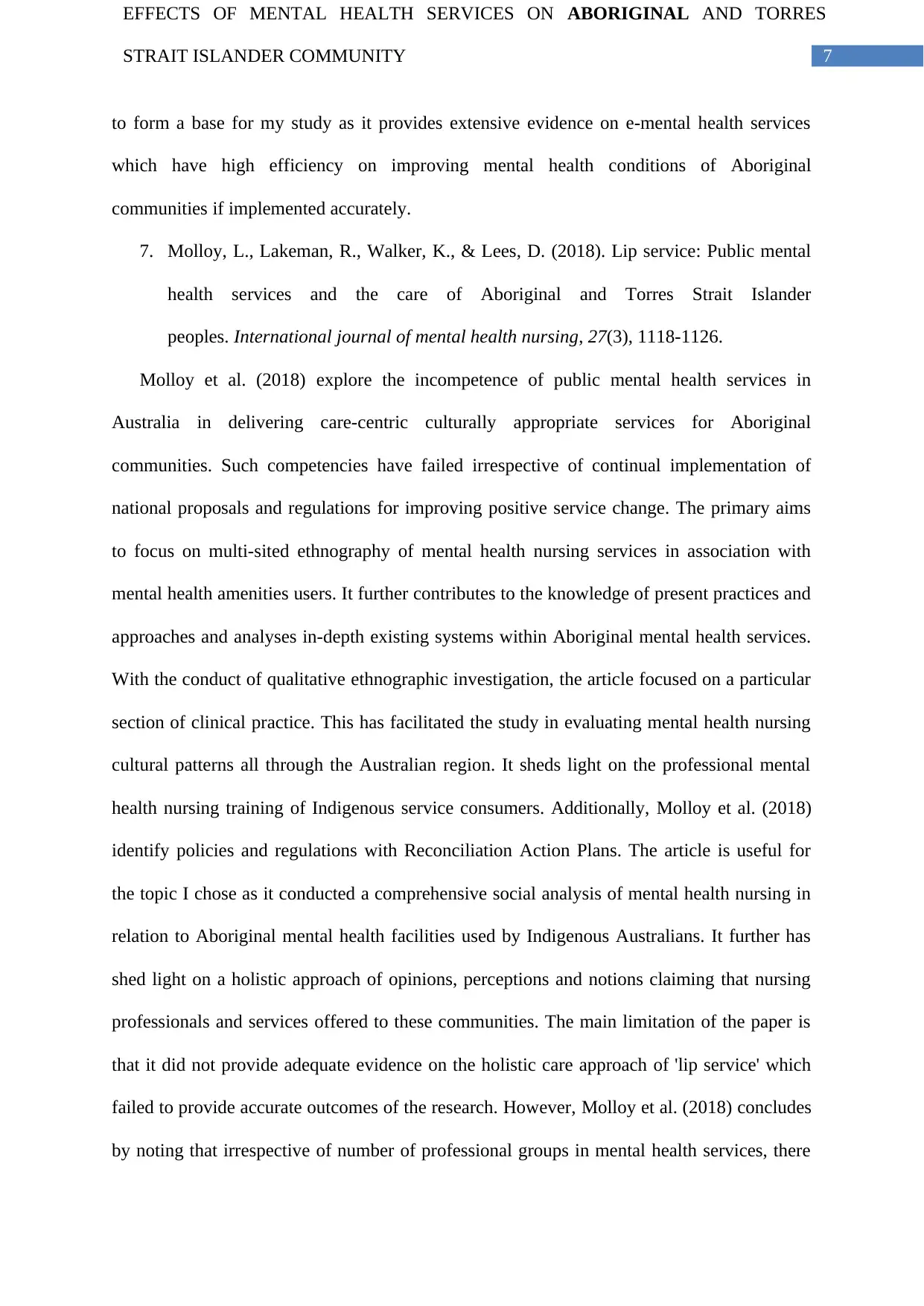
7
EFFECTS OF MENTAL HEALTH SERVICES ON ABORIGINAL AND TORRES
STRAIT ISLANDER COMMUNITY
to form a base for my study as it provides extensive evidence on e-mental health services
which have high efficiency on improving mental health conditions of Aboriginal
communities if implemented accurately.
7. Molloy, L., Lakeman, R., Walker, K., & Lees, D. (2018). Lip service: Public mental
health services and the care of Aboriginal and Torres Strait Islander
peoples. International journal of mental health nursing, 27(3), 1118-1126.
Molloy et al. (2018) explore the incompetence of public mental health services in
Australia in delivering care-centric culturally appropriate services for Aboriginal
communities. Such competencies have failed irrespective of continual implementation of
national proposals and regulations for improving positive service change. The primary aims
to focus on multi-sited ethnography of mental health nursing services in association with
mental health amenities users. It further contributes to the knowledge of present practices and
approaches and analyses in-depth existing systems within Aboriginal mental health services.
With the conduct of qualitative ethnographic investigation, the article focused on a particular
section of clinical practice. This has facilitated the study in evaluating mental health nursing
cultural patterns all through the Australian region. It sheds light on the professional mental
health nursing training of Indigenous service consumers. Additionally, Molloy et al. (2018)
identify policies and regulations with Reconciliation Action Plans. The article is useful for
the topic I chose as it conducted a comprehensive social analysis of mental health nursing in
relation to Aboriginal mental health facilities used by Indigenous Australians. It further has
shed light on a holistic approach of opinions, perceptions and notions claiming that nursing
professionals and services offered to these communities. The main limitation of the paper is
that it did not provide adequate evidence on the holistic care approach of 'lip service' which
failed to provide accurate outcomes of the research. However, Molloy et al. (2018) concludes
by noting that irrespective of number of professional groups in mental health services, there
EFFECTS OF MENTAL HEALTH SERVICES ON ABORIGINAL AND TORRES
STRAIT ISLANDER COMMUNITY
to form a base for my study as it provides extensive evidence on e-mental health services
which have high efficiency on improving mental health conditions of Aboriginal
communities if implemented accurately.
7. Molloy, L., Lakeman, R., Walker, K., & Lees, D. (2018). Lip service: Public mental
health services and the care of Aboriginal and Torres Strait Islander
peoples. International journal of mental health nursing, 27(3), 1118-1126.
Molloy et al. (2018) explore the incompetence of public mental health services in
Australia in delivering care-centric culturally appropriate services for Aboriginal
communities. Such competencies have failed irrespective of continual implementation of
national proposals and regulations for improving positive service change. The primary aims
to focus on multi-sited ethnography of mental health nursing services in association with
mental health amenities users. It further contributes to the knowledge of present practices and
approaches and analyses in-depth existing systems within Aboriginal mental health services.
With the conduct of qualitative ethnographic investigation, the article focused on a particular
section of clinical practice. This has facilitated the study in evaluating mental health nursing
cultural patterns all through the Australian region. It sheds light on the professional mental
health nursing training of Indigenous service consumers. Additionally, Molloy et al. (2018)
identify policies and regulations with Reconciliation Action Plans. The article is useful for
the topic I chose as it conducted a comprehensive social analysis of mental health nursing in
relation to Aboriginal mental health facilities used by Indigenous Australians. It further has
shed light on a holistic approach of opinions, perceptions and notions claiming that nursing
professionals and services offered to these communities. The main limitation of the paper is
that it did not provide adequate evidence on the holistic care approach of 'lip service' which
failed to provide accurate outcomes of the research. However, Molloy et al. (2018) concludes
by noting that irrespective of number of professional groups in mental health services, there
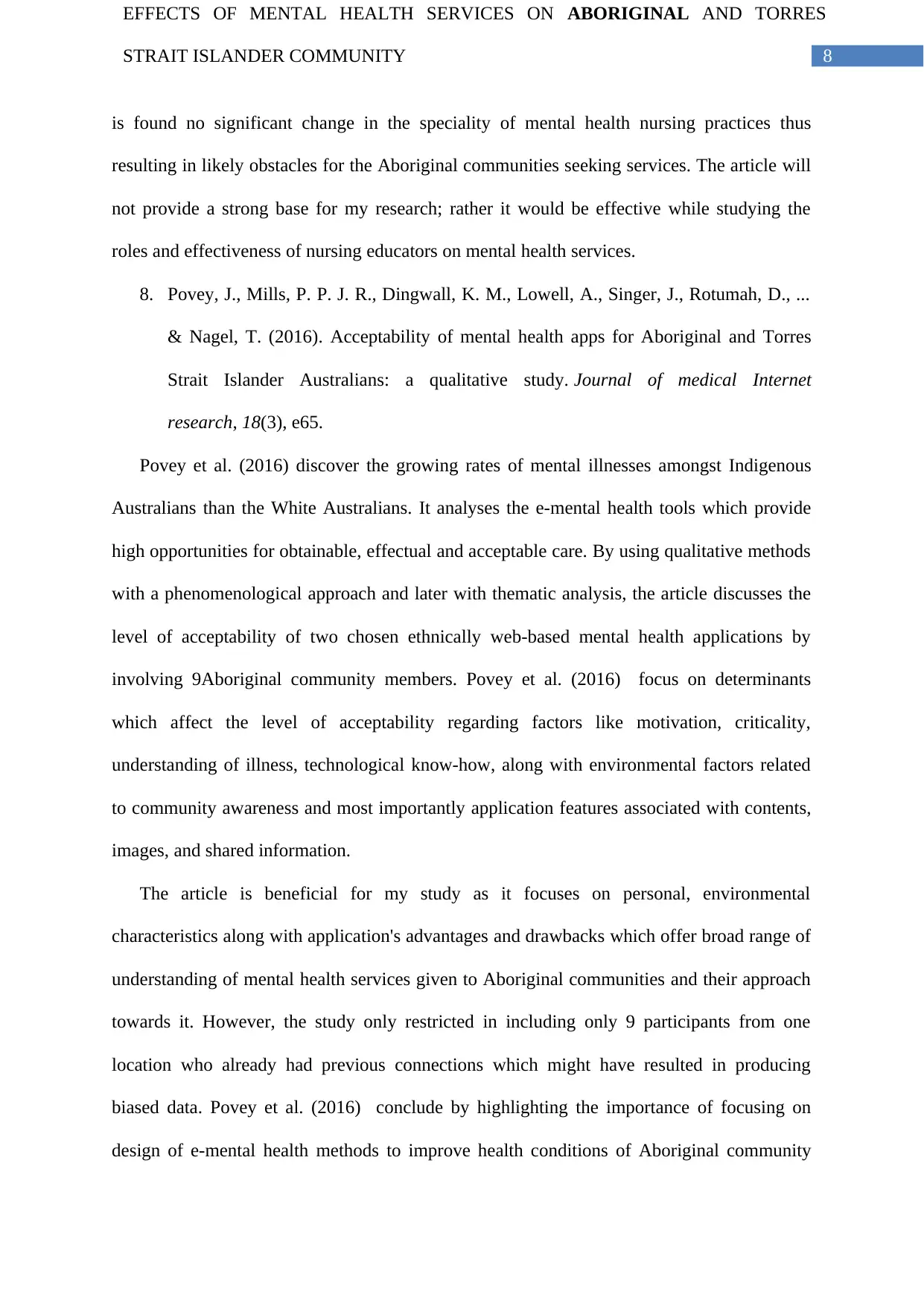
8
EFFECTS OF MENTAL HEALTH SERVICES ON ABORIGINAL AND TORRES
STRAIT ISLANDER COMMUNITY
is found no significant change in the speciality of mental health nursing practices thus
resulting in likely obstacles for the Aboriginal communities seeking services. The article will
not provide a strong base for my research; rather it would be effective while studying the
roles and effectiveness of nursing educators on mental health services.
8. Povey, J., Mills, P. P. J. R., Dingwall, K. M., Lowell, A., Singer, J., Rotumah, D., ...
& Nagel, T. (2016). Acceptability of mental health apps for Aboriginal and Torres
Strait Islander Australians: a qualitative study. Journal of medical Internet
research, 18(3), e65.
Povey et al. (2016) discover the growing rates of mental illnesses amongst Indigenous
Australians than the White Australians. It analyses the e-mental health tools which provide
high opportunities for obtainable, effectual and acceptable care. By using qualitative methods
with a phenomenological approach and later with thematic analysis, the article discusses the
level of acceptability of two chosen ethnically web-based mental health applications by
involving 9Aboriginal community members. Povey et al. (2016) focus on determinants
which affect the level of acceptability regarding factors like motivation, criticality,
understanding of illness, technological know-how, along with environmental factors related
to community awareness and most importantly application features associated with contents,
images, and shared information.
The article is beneficial for my study as it focuses on personal, environmental
characteristics along with application's advantages and drawbacks which offer broad range of
understanding of mental health services given to Aboriginal communities and their approach
towards it. However, the study only restricted in including only 9 participants from one
location who already had previous connections which might have resulted in producing
biased data. Povey et al. (2016) conclude by highlighting the importance of focusing on
design of e-mental health methods to improve health conditions of Aboriginal community
EFFECTS OF MENTAL HEALTH SERVICES ON ABORIGINAL AND TORRES
STRAIT ISLANDER COMMUNITY
is found no significant change in the speciality of mental health nursing practices thus
resulting in likely obstacles for the Aboriginal communities seeking services. The article will
not provide a strong base for my research; rather it would be effective while studying the
roles and effectiveness of nursing educators on mental health services.
8. Povey, J., Mills, P. P. J. R., Dingwall, K. M., Lowell, A., Singer, J., Rotumah, D., ...
& Nagel, T. (2016). Acceptability of mental health apps for Aboriginal and Torres
Strait Islander Australians: a qualitative study. Journal of medical Internet
research, 18(3), e65.
Povey et al. (2016) discover the growing rates of mental illnesses amongst Indigenous
Australians than the White Australians. It analyses the e-mental health tools which provide
high opportunities for obtainable, effectual and acceptable care. By using qualitative methods
with a phenomenological approach and later with thematic analysis, the article discusses the
level of acceptability of two chosen ethnically web-based mental health applications by
involving 9Aboriginal community members. Povey et al. (2016) focus on determinants
which affect the level of acceptability regarding factors like motivation, criticality,
understanding of illness, technological know-how, along with environmental factors related
to community awareness and most importantly application features associated with contents,
images, and shared information.
The article is beneficial for my study as it focuses on personal, environmental
characteristics along with application's advantages and drawbacks which offer broad range of
understanding of mental health services given to Aboriginal communities and their approach
towards it. However, the study only restricted in including only 9 participants from one
location who already had previous connections which might have resulted in producing
biased data. Povey et al. (2016) conclude by highlighting the importance of focusing on
design of e-mental health methods to improve health conditions of Aboriginal community
⊘ This is a preview!⊘
Do you want full access?
Subscribe today to unlock all pages.

Trusted by 1+ million students worldwide
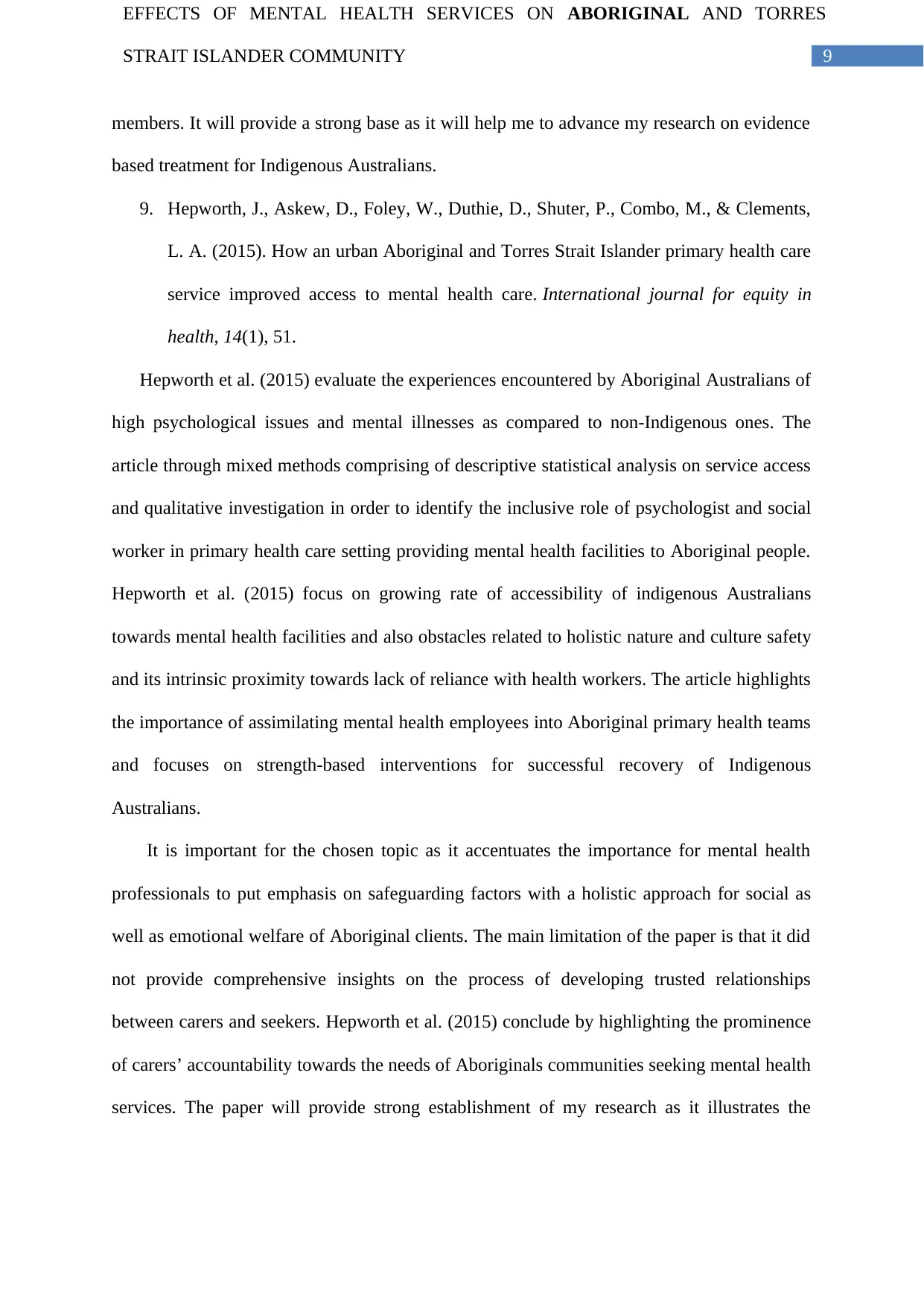
9
EFFECTS OF MENTAL HEALTH SERVICES ON ABORIGINAL AND TORRES
STRAIT ISLANDER COMMUNITY
members. It will provide a strong base as it will help me to advance my research on evidence
based treatment for Indigenous Australians.
9. Hepworth, J., Askew, D., Foley, W., Duthie, D., Shuter, P., Combo, M., & Clements,
L. A. (2015). How an urban Aboriginal and Torres Strait Islander primary health care
service improved access to mental health care. International journal for equity in
health, 14(1), 51.
Hepworth et al. (2015) evaluate the experiences encountered by Aboriginal Australians of
high psychological issues and mental illnesses as compared to non-Indigenous ones. The
article through mixed methods comprising of descriptive statistical analysis on service access
and qualitative investigation in order to identify the inclusive role of psychologist and social
worker in primary health care setting providing mental health facilities to Aboriginal people.
Hepworth et al. (2015) focus on growing rate of accessibility of indigenous Australians
towards mental health facilities and also obstacles related to holistic nature and culture safety
and its intrinsic proximity towards lack of reliance with health workers. The article highlights
the importance of assimilating mental health employees into Aboriginal primary health teams
and focuses on strength-based interventions for successful recovery of Indigenous
Australians.
It is important for the chosen topic as it accentuates the importance for mental health
professionals to put emphasis on safeguarding factors with a holistic approach for social as
well as emotional welfare of Aboriginal clients. The main limitation of the paper is that it did
not provide comprehensive insights on the process of developing trusted relationships
between carers and seekers. Hepworth et al. (2015) conclude by highlighting the prominence
of carers’ accountability towards the needs of Aboriginals communities seeking mental health
services. The paper will provide strong establishment of my research as it illustrates the
EFFECTS OF MENTAL HEALTH SERVICES ON ABORIGINAL AND TORRES
STRAIT ISLANDER COMMUNITY
members. It will provide a strong base as it will help me to advance my research on evidence
based treatment for Indigenous Australians.
9. Hepworth, J., Askew, D., Foley, W., Duthie, D., Shuter, P., Combo, M., & Clements,
L. A. (2015). How an urban Aboriginal and Torres Strait Islander primary health care
service improved access to mental health care. International journal for equity in
health, 14(1), 51.
Hepworth et al. (2015) evaluate the experiences encountered by Aboriginal Australians of
high psychological issues and mental illnesses as compared to non-Indigenous ones. The
article through mixed methods comprising of descriptive statistical analysis on service access
and qualitative investigation in order to identify the inclusive role of psychologist and social
worker in primary health care setting providing mental health facilities to Aboriginal people.
Hepworth et al. (2015) focus on growing rate of accessibility of indigenous Australians
towards mental health facilities and also obstacles related to holistic nature and culture safety
and its intrinsic proximity towards lack of reliance with health workers. The article highlights
the importance of assimilating mental health employees into Aboriginal primary health teams
and focuses on strength-based interventions for successful recovery of Indigenous
Australians.
It is important for the chosen topic as it accentuates the importance for mental health
professionals to put emphasis on safeguarding factors with a holistic approach for social as
well as emotional welfare of Aboriginal clients. The main limitation of the paper is that it did
not provide comprehensive insights on the process of developing trusted relationships
between carers and seekers. Hepworth et al. (2015) conclude by highlighting the prominence
of carers’ accountability towards the needs of Aboriginals communities seeking mental health
services. The paper will provide strong establishment of my research as it illustrates the
Paraphrase This Document
Need a fresh take? Get an instant paraphrase of this document with our AI Paraphraser
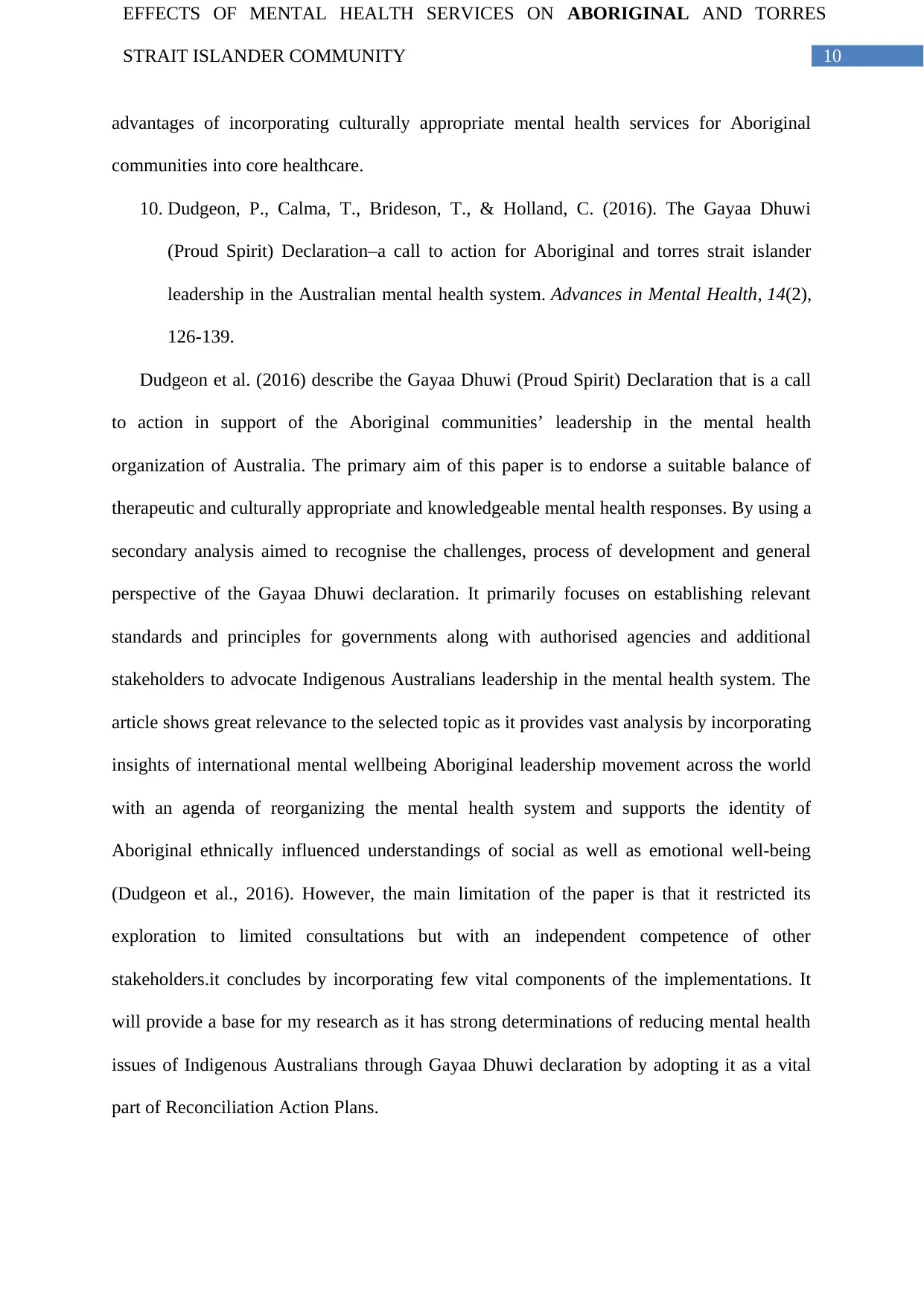
10
EFFECTS OF MENTAL HEALTH SERVICES ON ABORIGINAL AND TORRES
STRAIT ISLANDER COMMUNITY
advantages of incorporating culturally appropriate mental health services for Aboriginal
communities into core healthcare.
10. Dudgeon, P., Calma, T., Brideson, T., & Holland, C. (2016). The Gayaa Dhuwi
(Proud Spirit) Declaration–a call to action for Aboriginal and torres strait islander
leadership in the Australian mental health system. Advances in Mental Health, 14(2),
126-139.
Dudgeon et al. (2016) describe the Gayaa Dhuwi (Proud Spirit) Declaration that is a call
to action in support of the Aboriginal communities’ leadership in the mental health
organization of Australia. The primary aim of this paper is to endorse a suitable balance of
therapeutic and culturally appropriate and knowledgeable mental health responses. By using a
secondary analysis aimed to recognise the challenges, process of development and general
perspective of the Gayaa Dhuwi declaration. It primarily focuses on establishing relevant
standards and principles for governments along with authorised agencies and additional
stakeholders to advocate Indigenous Australians leadership in the mental health system. The
article shows great relevance to the selected topic as it provides vast analysis by incorporating
insights of international mental wellbeing Aboriginal leadership movement across the world
with an agenda of reorganizing the mental health system and supports the identity of
Aboriginal ethnically influenced understandings of social as well as emotional well-being
(Dudgeon et al., 2016). However, the main limitation of the paper is that it restricted its
exploration to limited consultations but with an independent competence of other
stakeholders.it concludes by incorporating few vital components of the implementations. It
will provide a base for my research as it has strong determinations of reducing mental health
issues of Indigenous Australians through Gayaa Dhuwi declaration by adopting it as a vital
part of Reconciliation Action Plans.
EFFECTS OF MENTAL HEALTH SERVICES ON ABORIGINAL AND TORRES
STRAIT ISLANDER COMMUNITY
advantages of incorporating culturally appropriate mental health services for Aboriginal
communities into core healthcare.
10. Dudgeon, P., Calma, T., Brideson, T., & Holland, C. (2016). The Gayaa Dhuwi
(Proud Spirit) Declaration–a call to action for Aboriginal and torres strait islander
leadership in the Australian mental health system. Advances in Mental Health, 14(2),
126-139.
Dudgeon et al. (2016) describe the Gayaa Dhuwi (Proud Spirit) Declaration that is a call
to action in support of the Aboriginal communities’ leadership in the mental health
organization of Australia. The primary aim of this paper is to endorse a suitable balance of
therapeutic and culturally appropriate and knowledgeable mental health responses. By using a
secondary analysis aimed to recognise the challenges, process of development and general
perspective of the Gayaa Dhuwi declaration. It primarily focuses on establishing relevant
standards and principles for governments along with authorised agencies and additional
stakeholders to advocate Indigenous Australians leadership in the mental health system. The
article shows great relevance to the selected topic as it provides vast analysis by incorporating
insights of international mental wellbeing Aboriginal leadership movement across the world
with an agenda of reorganizing the mental health system and supports the identity of
Aboriginal ethnically influenced understandings of social as well as emotional well-being
(Dudgeon et al., 2016). However, the main limitation of the paper is that it restricted its
exploration to limited consultations but with an independent competence of other
stakeholders.it concludes by incorporating few vital components of the implementations. It
will provide a base for my research as it has strong determinations of reducing mental health
issues of Indigenous Australians through Gayaa Dhuwi declaration by adopting it as a vital
part of Reconciliation Action Plans.
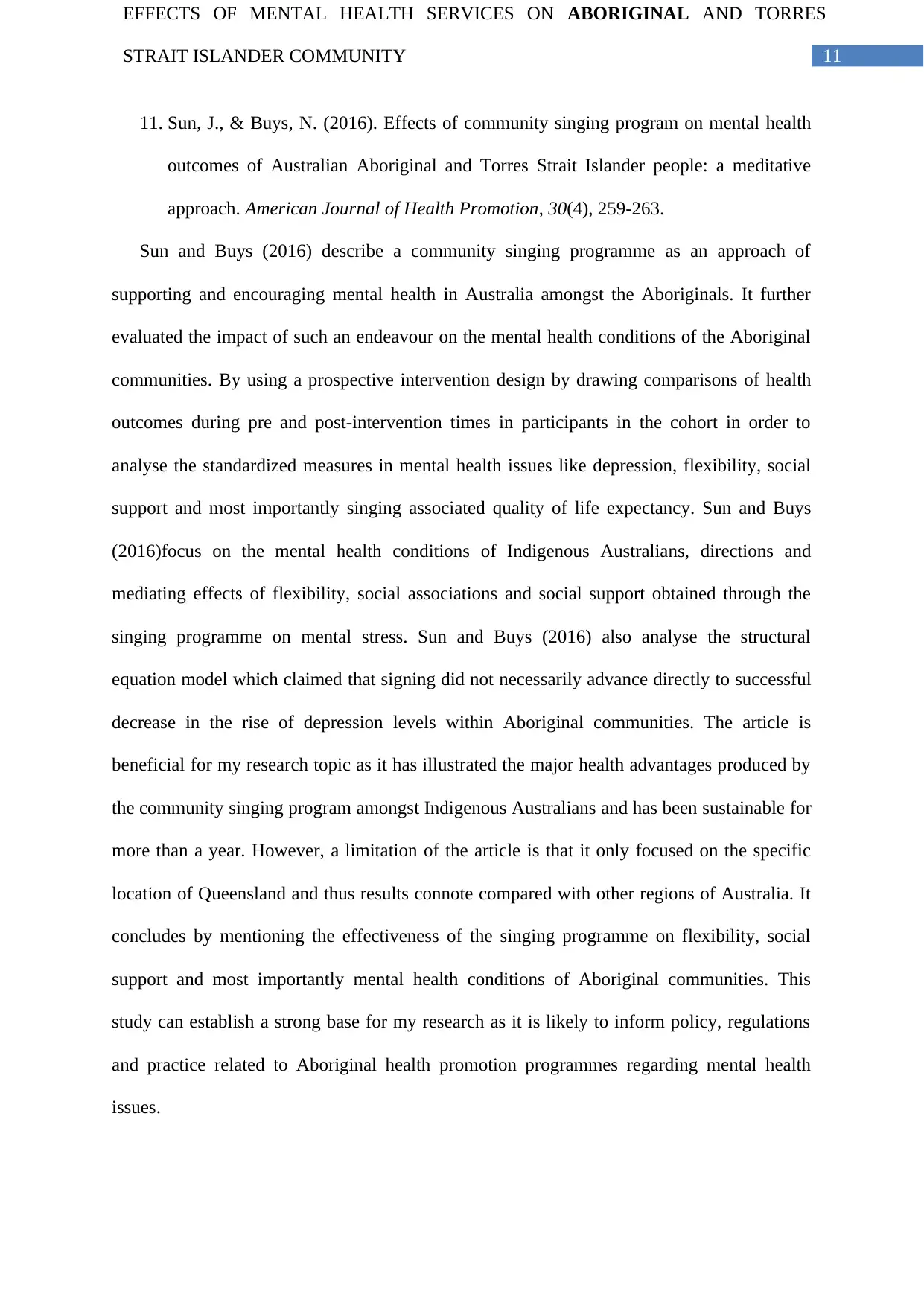
11
EFFECTS OF MENTAL HEALTH SERVICES ON ABORIGINAL AND TORRES
STRAIT ISLANDER COMMUNITY
11. Sun, J., & Buys, N. (2016). Effects of community singing program on mental health
outcomes of Australian Aboriginal and Torres Strait Islander people: a meditative
approach. American Journal of Health Promotion, 30(4), 259-263.
Sun and Buys (2016) describe a community singing programme as an approach of
supporting and encouraging mental health in Australia amongst the Aboriginals. It further
evaluated the impact of such an endeavour on the mental health conditions of the Aboriginal
communities. By using a prospective intervention design by drawing comparisons of health
outcomes during pre and post-intervention times in participants in the cohort in order to
analyse the standardized measures in mental health issues like depression, flexibility, social
support and most importantly singing associated quality of life expectancy. Sun and Buys
(2016)focus on the mental health conditions of Indigenous Australians, directions and
mediating effects of flexibility, social associations and social support obtained through the
singing programme on mental stress. Sun and Buys (2016) also analyse the structural
equation model which claimed that signing did not necessarily advance directly to successful
decrease in the rise of depression levels within Aboriginal communities. The article is
beneficial for my research topic as it has illustrated the major health advantages produced by
the community singing program amongst Indigenous Australians and has been sustainable for
more than a year. However, a limitation of the article is that it only focused on the specific
location of Queensland and thus results connote compared with other regions of Australia. It
concludes by mentioning the effectiveness of the singing programme on flexibility, social
support and most importantly mental health conditions of Aboriginal communities. This
study can establish a strong base for my research as it is likely to inform policy, regulations
and practice related to Aboriginal health promotion programmes regarding mental health
issues.
EFFECTS OF MENTAL HEALTH SERVICES ON ABORIGINAL AND TORRES
STRAIT ISLANDER COMMUNITY
11. Sun, J., & Buys, N. (2016). Effects of community singing program on mental health
outcomes of Australian Aboriginal and Torres Strait Islander people: a meditative
approach. American Journal of Health Promotion, 30(4), 259-263.
Sun and Buys (2016) describe a community singing programme as an approach of
supporting and encouraging mental health in Australia amongst the Aboriginals. It further
evaluated the impact of such an endeavour on the mental health conditions of the Aboriginal
communities. By using a prospective intervention design by drawing comparisons of health
outcomes during pre and post-intervention times in participants in the cohort in order to
analyse the standardized measures in mental health issues like depression, flexibility, social
support and most importantly singing associated quality of life expectancy. Sun and Buys
(2016)focus on the mental health conditions of Indigenous Australians, directions and
mediating effects of flexibility, social associations and social support obtained through the
singing programme on mental stress. Sun and Buys (2016) also analyse the structural
equation model which claimed that signing did not necessarily advance directly to successful
decrease in the rise of depression levels within Aboriginal communities. The article is
beneficial for my research topic as it has illustrated the major health advantages produced by
the community singing program amongst Indigenous Australians and has been sustainable for
more than a year. However, a limitation of the article is that it only focused on the specific
location of Queensland and thus results connote compared with other regions of Australia. It
concludes by mentioning the effectiveness of the singing programme on flexibility, social
support and most importantly mental health conditions of Aboriginal communities. This
study can establish a strong base for my research as it is likely to inform policy, regulations
and practice related to Aboriginal health promotion programmes regarding mental health
issues.
⊘ This is a preview!⊘
Do you want full access?
Subscribe today to unlock all pages.

Trusted by 1+ million students worldwide
1 out of 15
Related Documents
Your All-in-One AI-Powered Toolkit for Academic Success.
+13062052269
info@desklib.com
Available 24*7 on WhatsApp / Email
![[object Object]](/_next/static/media/star-bottom.7253800d.svg)
Unlock your academic potential
Copyright © 2020–2025 A2Z Services. All Rights Reserved. Developed and managed by ZUCOL.





